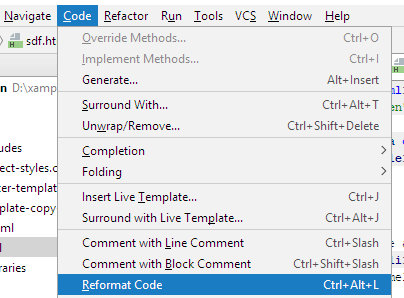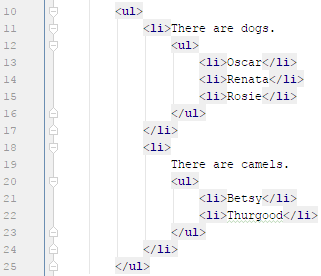The story so far
You know how to put files on servers, so they show up on the web. You've learned a couple of HTML tags. Time for some more.
Unordered lists
Unordered lists look like this:
- An item
- Another item
- Yet another item
They're called "unordered" because they just show bullets in front of each item, rather than numbers.
Make a list like this:
<ul>
<li>An item</li>
<li>Another item</li>
<li>Yet another item</li>
</ul>The <li> tags are nested inside the <ul> tags. It's important to get the nesting right.
Also notice that I indented the <li> tags. The visual layout of the code matches the nesting of the HTML tags. The indenting makes the page easier to change. If you need to add things in the middle of the list, for example, the indenting will help you figure out exactly where your new data needs to go.
Ordered lists
The code for an ordered list is very similar. Change the <ul> to an <ol>, and you've got it.
<ol>
<li>An item</li>
<li>Another item</li>
<li>Yet another item</li>
</ol>It looks like:
- An item
- Another item
- Yet another item
Nested lists
Lists can be nested, that is, one list can be entirely inside another list. Here's some code.
<ul>
<li>19th century
<ul>
<li>1836: Eunice (mastiff) crowned Bitch of New South Wales.</li>
<li>1840:
<ol>
<li>Isaac (lab) eats 15 pounds of figs at Moreton Bay.</li>
<li>Thark (sheltie) barks for 17 hours nonstop. Riots in Port Jackson.</li>
</ol>
</li>
<li>1895: Booblo (Welsh terrier) marks Barton as future PM.</li>
</ul>
</li>
<li>20th century
<ul>
<li>1915: Groft (border collie) rescues sausages under fire.</li>
<li>1967: Lilabeth (portuguese water dog) directs shark to prime ministerial snack.</li>
<li>1975:
<ol>
<li>Goofer (collie) bites PM.</li>
<li>Goofer (collie) bites PM again.</li>
<li>Kerr (govenor general) bites PM.</li>
<li>Goofer (collie) becomes PM.</li>
</ol>
</li>
</ul>
</li>
</ul>Here's how it renders:
- 19th century
- 1836: Eunice (mastiff) crowned Bitch of New South Wales.
- 1840:
- Isaac (lab) eats 15 pounds of figs at Moreton Bay.
- Thark (sheltie) barks for 17 hours nonstop. Riots in Port Jackson.
- 1895: Booblo (Welsh terrier) marks Barton as future PM.
- 20th century
- 1915: Groft (border collie) rescues sausages under fire.
- 1967: Lilabeth (portuguese water dog) directs shark to prime ministerial snack.
- 1975:
- Goofer (collie) bites PM.
- Goofer (collie) bites PM again.
- Kerr (govenor general) bites PM.
- Goofer (collie) becomes PM.
Notice that:
- Lists can be nested to any depth.
- Ordered lists can be nested inside unordered lists. The reverse is also true; unordered lists can be nested inside ordered lists.
- Inner lists are completely contained within
<li>tags of outer lists.
Comments
The HTML for the nested list is complex. It's easy to mess up the nesting.
When you write complex code, you can add comments, to explain what's going on. For example:
<li>1975:
<!-- Nested list of events for 1975. -->
<ol>
<li>Goofer (collie) bites PM.</li>
<li>Goofer (collie) bites PM again.</li>
<li>Kerr (govenor general) bites PM.</li>
<li>Goofer (collie) becomes PM.</li>
</ol>
<!-- End of nested list of events for 1975. -->
</li>Add as many comments as you like. They're great when tags are wrapped in other tags, like nested lists. There are 26 lines of HTML between the first <ul>, and its closing tag </ul>. It's easy to lose track of what tags belong together. Indenting and comments help.
There's a complete list of coding standards for the course.
Whitespace again
Here's one of those lists again:
<ol>
<li>An item</li>
<li>Another item</li>
<li>Yet another item</li>
</ol>Browsers don't care about extra whitespace. This would render the same:
<ol><li>An item</li><li>Another item</li><li>Yet another item</li></ol>Ack! That's a mess.
The indenting is essential in figuring things out. Not for the computer, but for a person trying to update the list.
IDEs do it for you
Here's a list I typed into WebStorm:

Ack! What a mess! Good luck figuring out what that will do.
WebStorm can reformat code for you:

One Ctrl+Alt+L later, and here's what the code looked like:

Aaaahhhh! That's better.

Be sure to indent your code.
Make a directory in your littlehtml subdomain for this exercise. Upload your file to the directory. Submit the URL.
(If you were logged in as a student, you could submit an exercise solution, and get some feedback.)
Summary
<ul>makes a list with bullets. Use<li>for each list item.<ol>makes a list with number. Use<li>for each list item.- Indent list elements to make them easier to follow.
- IDEs can reformat code for you.
